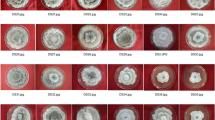Abstract
Genetic diversity in Ascochyta rabiei (Pass.) Labr., the causative agent of ascochyta blight of chickpea, was determined using 37 Indian, five American (USA), three Syrian, and two Pakistani isolates. A total of 48 polymorphic RAPD markers were scored for each isolate and the data used for cluster analysis. Most of the isolates clustered in the dendrogram essentially according to geographic origin. Based on the two major clusters A and B, Indian isolates were grouped into two categories, type-A and type-B. Isolates of A. rabiei within the Punjab state were more diverse than isolates from other states in northwestern India. A DNA marker (ubc7561.6 kb), specific to Indian isolates was identified. This is the first report of a molecular diversity analysis of Indian isolates of A. rabiei. The information may assist Indian chickpea breeders in the proper deployment of blight-resistant cultivars and in disease management.
Similar content being viewed by others
Author information
Authors and Affiliations
Additional information
Received: 25 April 2000 / Accepted: 11 July 2000
Rights and permissions
About this article
Cite this article
Santra, D., Singh, G., Kaiser, W. et al. Molecular analysis of Ascochyta rabiei (Pass.) Labr., the pathogen of ascochyta blight in chickpea. Theor Appl Genet 102, 676–682 (2001). https://doi.org/10.1007/s001220051696
Issue Date:
DOI: https://doi.org/10.1007/s001220051696




